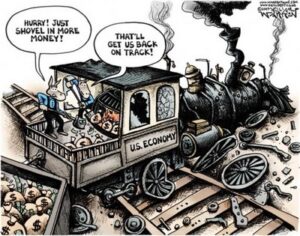 By Bill Wilson — Here we go again.
By Bill Wilson — Here we go again.
On Sept. 13, the Federal Reserve announced a program to purchase $40 billion of mortgage-backed securities a month — at a pace of $480 billion a year. Unlike previous incarnations of quantitative easing (QE), this one is open-ended with no sunset stated or envisioned.
“If the outlook for the labor market does not improve substantially, the committee will continue its purchase of agency mortgage-backed securities, undertake additional asset purchases, and employ its other policy tools as appropriate until such improvement is achieved in a context of price stability,” the Fed wrote in its statement.
This is a harsh indictment of the Fed’s own actions to date. Since Aug. 2007 when the financial crisis is thought to have begun, the Fed has increased its balance sheet from $897 billion to $2.805 trillion today, more than tripling it.
At the height of its bailout programs, it bought some $1.25 trillion of dodgy mortgage-backed securities that had been issued by Fannie Mae, Freddie Mac, and Ginnie Mae from financial institutions. $442.7 billion was purchased from foreign banks.
At the time the Fed said this action on Nov. 25, 2008 would “increase the availability of credit for the purchase of houses, which in turn should support housing markets and foster improved conditions in financial markets.”
In addition, the Fed increased its holdings of U.S. treasuries from $790.8 billion to more than $1.648 trillion today — a direct monetization of the nation’s $16 trillion national debt. In other words, we are printing money to refinance and expand our debt.
On Nov. 3, 2010 — a day after the congressional midterms — the Fed announced QE2, the colloquial term for its $600 billion of additional treasuries purchases. At the time, it said it was doing so to “promote a stronger pace of economic recovery”.
On Dec. 16, 2008, the Fed had also lowered the federal funds target rate to near-zero percent, it said, to “promote the resumption of sustainable economic growth”. It noted at the time that “weak economic conditions are likely to warrant exceptionally low levels of the federal funds rate for some time.”
There the federal funds rate has stood ever since. In the meantime, the easy money from the Fed has lowered the borrowing costs both for mortgages and for the federal government. 15-year fixed rate mortgages can be had for less than 3 percent. 10-year treasuries stand at an absurdly low 1.7 percent.
By every measure, the Fed’s unprecedented actions have been significantly larger and more aggressive than anything the central bank has ever done in the past — perhaps with the exception of monetizing the debts racked up during the world wars.
But there’s a problem. None of it has worked.
It could not prevent the housing market downturn — indeed, its easy money and too-low interest rates had helped cause it. It has not restored sustainable economic growth. And unemployment is still unacceptably high.
Critically, the amount of credit outstanding nationwide has been flat since 2008 at roughly $54 trillion. In other words, all this easy money has not facilitated bank lending as designed. That was after 65 years where the amount of credit had roughly doubled every ten years.
Specifically, housing has not recovered. Not really. Mortgage debt has been declining since 2008 by the Fed’s own data, and home prices have more or less cratered despite multiple sugar doses by the Fed and other government sources.
If the last $2 trillion of monetary expansion and easy money did not cure markets or restore robust growth, what makes the Fed think another $480 billion will do the trick?
By the Fed’s own benchmarks, it has been a marked failure.
Never has so much been done to so little effect. At least, not since Japan did precisely the same thing in the 1990s and 2000s after its real estate bubble popped.
When coupled with the European Central Bank’s (ECB) Sept. 6 announcement of open-ended government bond purchases, this is the absolute final gasp of the central bank cartel. They are desperate. These coordinated actions indicate only one thing: the global economy is going over a cliff. Name one region or industry that is prospering. Not China as its exports dry up. Not Australia who is just now entering its own housing meltdown. Certainly not Europe where even Germany is starting to show signs of recession. And the emerging economy nations? They depend on others to buy their commodities and goods. They are just months away from their own problems.
Bernanke has now fired his last bullet. When this reckless move fails, nobody will believe just shoveling more money into a broken economic engine will do anything meaningful.
Now is the time to begin a serious discussion of the only alternative available to us: sound money. The central banks are impotent, and people the world over will only suffer as a result until their stranglehold on power is broken and the regime of fiat money is replaced with an honest currency of real value.
Bill Wilson is the President of Americans for Limited Government. You can follow Bill on Twitter at @BillWilsonALG.






